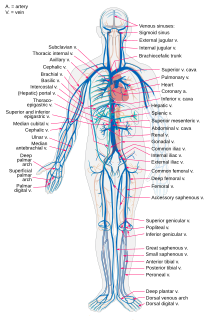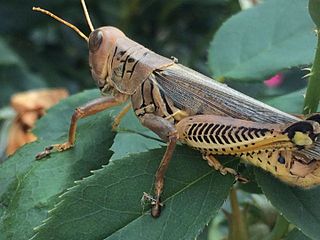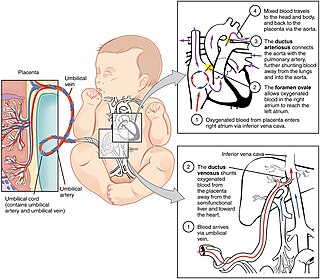
As in other molluscs, the circulatory system of gastropods is open, with the fluid, or haemolymph, flowing through sinuses and bathing the tissues directly. The haemolymph typically contains haemocyanin, and is blue in colour.

As in other molluscs, the circulatory system of gastropods is open, with the fluid, or haemolymph, flowing through sinuses and bathing the tissues directly. The haemolymph typically contains haemocyanin, and is blue in colour.
The heart is muscular and located in the anterior part of the visceral mass. In the great majority of species, it has two chambers; an auricle, which receives haemolymph from the gill or lung, and a ventricle, which pumps it into the aorta. However, some primitive gastropods possess two gills, each supplying its own auricle, so that their heart has three chambers.[ citation needed ]
The aorta is relatively short, and soon divides into two main vessels, one supplying the visceral mass, and the other supplying the head and foot. In some groups, these two vessels arise directly from the heart, so that the animal may be said to have two aortas. These two vessels in turn divide into many finer vessels throughout the body, and deliver haemolymph to open arterial sinuses where it bathes and oxygenates the tissues.
De-oxygenated haemolymph drains into a large venous sinus within the head and foot, which contains the nephridium, an excretory organ with a function similar to that of the vertebrate kidney. From here it passes into vessels within the gill, or into the capillary network of the pulmonate lung, before returning to the heart.
In some genera, such as the large marine snail Busycon , the main anterior artery (which supplies the head and foot) includes an enlarged muscular region. This structure is effectively a secondary heart, and probably helps to maintain blood pressure in the vessels of the head.
Because of the open circulatory system of gastropods and other molluscs, there is no clear distinction between the blood and the lymph, or interstitial fluid. As a result, the circulatory fluid is commonly referred to as haemolymph, rather than blood.
The majority of gastropods have haemolymph containing the respiratory pigment haemocyanin. This is a copper-containing protein that helps to carry oxygen, and gives the haemolymph a pale blue colour. In the freshwater Planorbid snails, however, the haemocyanin is replaced by haemoglobin, and thus their haemolymph is red rather than blue. Some gastropods, such as the sea hare Aplysia , appear to lack respiratory pigments altogether.
Regardless of whether they employ haemocyanin or haemoglobin, the pigments are dissolved directly in the serum, with no equivalent of the red blood cells found in mammals. However, the haemolymph does contain amoebocytes, which may have a role in the immune system.

The aorta is the main and largest artery in the human body, originating from the left ventricle of the heart and extending down to the abdomen, where it splits into two smaller arteries. The aorta distributes oxygenated blood to all parts of the body through the systemic circulation.

An artery is a blood vessel in humans, and most other animals that takes blood away from the heart to one or more parts of the body. Most arteries carry oxygenated blood; the two exceptions are the pulmonary and the umbilical arteries, which carry deoxygenated blood to the organs that oxygenate it. The effective arterial blood volume is that extracellular fluid which fills the arterial system.

The heart is a muscular organ in most animals, which pumps blood through the blood vessels of the circulatory system. The pumped blood carries oxygen and nutrients to the body, while carrying metabolic waste such as carbon dioxide to the lungs. In humans, the heart is approximately the size of a closed fist and is located between the lungs, in the middle compartment of the chest.

The blood vessels are the components of the circulatory system that transport blood throughout the human body. These vessels transport blood cells, nutrients, and oxygen to the tissues of the body. They also take waste and carbon dioxide away from the tissues. Blood vessels are needed to sustain life, because all of the body's tissues rely on their functionality.

Veins are blood vessels in humans, and most other animals that carry blood towards the heart. Most veins carry deoxygenated blood from the tissues back to the heart; exceptions are the pulmonary and umbilical veins, both of which carry oxygenated blood to the heart. In contrast to veins, arteries carry blood away from the heart.

The circulatory system, also called the cardiovascular system or the vascular system, is an organ system that permits blood to circulate and transport nutrients, oxygen, carbon dioxide, hormones, and blood cells to and from the cells in the body to provide nourishment and help in fighting diseases, stabilize temperature and pH, and maintain homeostasis.

Coronary circulation is the circulation of blood in the blood vessels that supply the heart muscle (myocardium). Coronary arteries supply oxygenated blood to the heart muscle. Cardiac veins then drain away the blood after it has been deoxygenated. Because the rest of the body, and most especially the brain, needs a steady supply of oxygenated blood that is free of all but the slightest interruptions, the heart is required to function continuously. Therefore its circulation is of major importance not only to its own tissues but to the entire body and even the level of consciousness of the brain from moment to moment. Interruptions of coronary circulation quickly cause heart attacks, in which the heart muscle is damaged by oxygen starvation. Such interruptions are usually caused by coronary ischemia linked to coronary artery disease, and sometimes to embolism from other causes like obstruction in blood flow through vessels.

Hemolymph, or haemolymph, is a fluid, analogous to the blood in vertebrates, that circulates in the interior of the arthropod (invertebrate) body, remaining in direct contact with the animal's tissues. It is composed of a fluid plasma in which hemolymph cells called hemocytes are suspended. In addition to hemocytes, the plasma also contains many chemicals. It is the major tissue type of the open circulatory system characteristic of arthropods. In addition, some non-arthropods such as molluscs possess a hemolymphatic circulatory system.

The pericardium, also called pericardial sac, is a double-walled sac containing the heart and the roots of the great vessels. It has two layers, an outer layer made of strong connective tissue, and an inner layer made of serous membrane. It encloses the pericardial cavity, which contains pericardial fluid, and defines the middle mediastinum. It separates the heart from interference of other structures, protects it against infection and blunt trauma, and lubricates the heart's movements.

Aquatic respiration is the process whereby an aquatic organism exchanges respiratory gases with water, obtaining oxygen from oxygen dissolved in water and excreting carbon dioxide and some other metabolic waste products into the water.

A pulmonary sequestration is a medical condition wherein a piece of tissue that ultimately develops into lung tissue is not attached to the pulmonary arterial blood supply, as is the case in normally developing lung. This sequestered tissue is therefore not connected to the normal bronchial airway architecture, and fails to function in, and contribute to, respiration of the organism.

In animals that give live birth, the fetal circulation is the circulatory system of a fetus. The term usually encompasses the entire fetoplacental circulation, which includes the umbilical cord and the blood vessels within the placenta that carry fetal blood.

The common octopus is a mollusc belonging to the class Cephalopoda. Octopus vulgaris is the most studied of all octopus species. It is cosmopolitan, that is, a global species, which ranges from the eastern Atlantic, extends from the Mediterranean Sea and the southern coast of England, to the southern coast of South Africa. It also occurs off the Azores, Canary Islands, and Cape Verde Islands. The species is also common in the Western Atlantic. The common octopus hunts at dusk. Crabs, crayfish, and bivalve molluscs are preferred, although the octopus eats almost anything it can catch. It is able to change colour to blend in with its surroundings, and is able to jump upon any unwary prey that strays across its path. Using its beak, it is able to break into the shells of shelled molluscs. Training experiments have shown the common octopus can distinguish the brightness, size, shape, and horizontal or vertical orientation of objects.

Fiona pinnata, common name Fiona, is a species of small pelagic nudibranch, a marine gastropod mollusk in the superfamily Fionoidea. This nudibranch species lives worldwide on floating objects on seas, and feeds mainly on barnacles, specifically goose barnacles in the genus Lepas.

Chrysomallon squamiferum, commonly known as the scaly-foot gastropod, scaly-foot snail, or sea pangolin, is a species of deep-sea hydrothermal-vent snail, a marine gastropod mollusc in the family Peltospiridae. This vent-endemic gastropod is known only from deep-sea hydrothermal vents in the Indian Ocean, where it has been found at depths of about 2,400–2,900 m (1.5–1.8 mi). C. squamiferum differs greatly from other deep-sea gastropods, even the closely related neomphalines. In 2019, it was declared endangered on the IUCN Red List, the first species to be listed as such due to risks from deep-sea mining of its vent habitat and also produce high-quality metal ores.

The excretory system of gastropods removes nitrogenous waste and maintains the internal water balance of these creatures, commonly referred to as snails and slugs. The primary organ of excretion is a nephridium.

Pseudunela cornuta is a species of minute sea slug, an acochlidian, a shell-less marine and temporarily brackish gastropod mollusk in the family Pseudunelidae. Adults are about 3 mm long and live in the spaces between sand grains.
Bathyacmaea secunda is a species of very small, deep-sea limpet, a marine gastropod mollusk in the family Pectinodontidae. This species inhabits the dark, chemosynthesis-based marine communities of ocean vents and cold seeps near Japan.

The pulmonary pleurae are the two opposing layers of serous membrane overlying the lungs and the inside of the surrounding chest walls.
Heart is a muscular organ sited in the mediastinum. It consist of four chambers, four valves, arteries, and the conduction system. Heart functionally can be separated in left and right side. Right heart receives blood coming from the body through superior and inferior vena cava. It pumps blood to the lungs through the pulmonary artery and left heart receives saturated blood from the lungs.